| |
Information
News and Exhibitions
Publications
Contact
Mailing List
Artist's Statement
Resume
Copyright
site
by Csik |
|
Quixotic efforts
Digging into the Nature of Experience
by Nancy Depew
Excerpt from:
Artists on Art
Fall 04
online magazine
October 2012
This is a fascinating time to be involved with art. Today, as artists, we are essentially self-governed. We choose between almost limitless options – a multitude of possibilities face us every time we make a work of art. But the choices carry such weight, determining our future and even our financial success or failure. I don’t claim to have all the answers, but I offer up here some of my own story and a few of the conclusions I’ve come to that may be helpful to any who are attempting to find their own path or to develop their own voice.
Like all gardeners in the Northeast, I spend the whole winter imagining the flowers that will bloom in my garden in the spring. I dream of them. I stare for hours out at the bare ground anticipating their arrival. This past spring, when they finally bloomed, I went out to cut my first beautiful peony of the season and yes, it was lovely, but the realization hit me the moment I touched the flower, it was just a flower. All the depth and the weight that I had waited for endlessly were not there. I was momentarily disoriented and even disheartened. But from years of experience, I knew what I needed to do. I took the flower into the studio and worked with it for hours until I coerced the image I was looking for from it. Only then could that flower turn into a work of art. The flower itself was very beautiful, but unremarkable. I wasn’t interested in documenting the flower for its own sake. I was interested in a collaboration between myself and that flower. The flower was a vehicle, loaded with all the implications a living organism embodies. It provided me with a means for channeling something internal. I feel the same about every subject. The mindless depiction of a subject is of little interest to me. It’s the artist that makes the art, not the subject matter. Technique is just another variable, not the end-all or the be-all of a real work of art. It’s the artist behind the paint that speaks to us, not the paint itself.
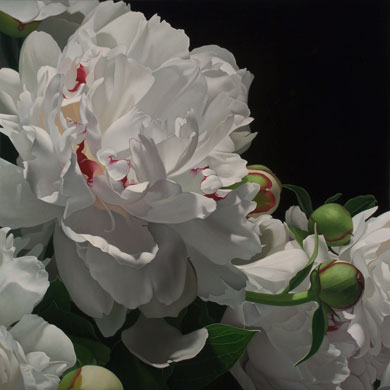
Sweet Talk, 40"x40", oil on canvas
My earliest memories are of painting and drawing. I have always been astounded by the process of turning a two-dimensional surface into a three-dimensional illusion. As a kid, I spent long hours drawing and gradually accumulated skills, more by accident than by intention. I didn’t study art formally until I signed up for a required art course in college in the early 1970s. I studied under an abstract expressionist painter and sculptor who believed that drawing the figure was an invaluable experience for any artist. I took to it wholeheartedly. I had free rein when it came to painting so I experimented with a all sorts of materials and approaches, but I was always aware of something internal that I needed to express. Sometimes it would materialize in my work, but I had no control over it. Many years of concerted effort would pass before I could piece together all the variables that would let me make the work I really wanted to make, a painting that I considered to be a real work of art, a painting through which I had knowingly orchestrated the expression of my intentions and gave form to that internal voice.
Early on, before I knew any better, I believed that I simply lacked the technical knowledge to execute a work of art. I felt fairly certain that the majority of my problems would be solved if I could just find out the right secrets, the right stuff. It was merely a simple matter of some technical knowledge that separated me from the art I hoped to make. I began accumulating every book I could get my hands on that dealt with the technical aspects of painting. I quickly learned a lot, and practice led to understanding, but it soon became very clear that the more one learns, the more there is to know. Although I began to make technically proficient paintings, I wasn’t necessarily making good art.
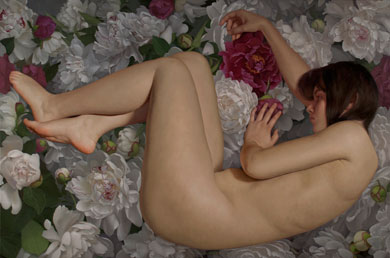
Drift, 40"x60", oil on canvas
It didn’t take long to realize that everything I could learn about, everything I experienced added to my ability to make a work of art. Having once been a horrible student, I found myself developing a real hunger for knowledge. I started taking art history seriously and began to study the work of artists outside of my comfort zone. But I also started developing an appetite for knowledge from a whole array of other fields, an appetite that hasn’t lapsed in all these years. I eventually found my way to graduate school, and it was there that I began to make serious progress sorting out all of the conflicting information, the wants and desires, the hopes, fears, agonizing uncertainty and downright confusion that were preventing me from moving on a path that felt right, my own path, using my own voice. I took many missteps along the way, and have learned many painful lessons, but they have all made me a better artist.
One difficulty I’ve had to struggle with comes from my real love of paint. I am thoroughly fascinated with the stuff and when I see the work of great painters, I am easily filled with lust for the techniques and approaches they use. But I found real danger in the desire to emulate other painters, and falling under their influence has often distracted me from my own story. It was an important lesson for me to learn – that I can appreciate the work of other artists, empathize and connect deeply with their work and their choices, but not necessarily work in that same manner. I am always fascinated to learn about how they approach their work, but I have placed my own voice and my own identity at the core of my work. I make the stylistic choices that best fit my intentions.
I try to avoid a formulaic approach to painting. I don’t have a set method that I repeat each time I work. I think of art-making as a process, where the experience of working leads to insight, revelation and discovery. It’s an adventure filled with perils and surprises. I try to respond to the artwork as it forms, choosing options that will lead me to learning the most I can from and about the work. This is often not the fastest way to make a painting. But it is the best way I have found for making art I’m happy with. There are thousands of options every time you pick up a brush. What will guide the decisions you make and what priorities will be revealed by those decisions? Those are the questions that fascinate me. My paintings are done only after I’ve resolved every question.
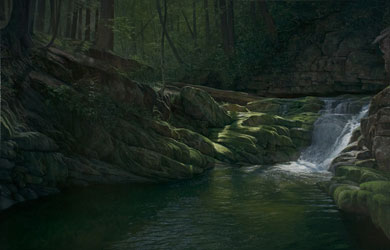
Weight, 36"x55", oil on canvas
So much of the conversation in the art world today revolves around the idea of good art exhibiting something new. I choose rather to focus on the idea of the work being honest, believing that honesty will unavoidably lead to originality. I’ll leave judgement as to the significance of the art I make to others. I focus my efforts on learning as much as I can, making the best work and the most honest work I can.
I still put a lot of emphasis on the technical aspect of my paintings, but I have come to think of technique in fluid terms, a tool I use to work for me. There are certain constants that I choose to work with again and again. I use the best materials I can get my hands on, simply because I find the results to be that much easier and better. I stick to a simple palette, mostly relying on primary colors so that I have to mix all the colors I use. I take mixing very seriously and use it as a way to learn everything I can about color.
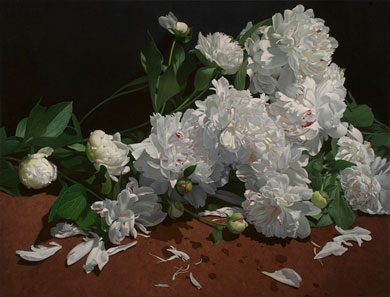 Persistence, 44"x58", oil on canvas Persistence, 44"x58", oil on canvas
When I start a painting, I begin with subject matter that I connect with deeply. While focusing on the intuitive aspects of the subject, I look for a visual, rather than a verbal idea. I find the words that eventually become titles during the process of painting. In my most recent work, I combine traditional layered painting techniques with more contemporary approaches to create a highly realized, three-dimensionally believable image, but I am not interested in documenting reality. I take many liberties with my subject matter. I use still life, landscape and the figure as a vehicle for a highly orchestrated exploration of a metaphysical terrain. I dig into the nature of experience.
Over the years I’ve continued to challenge myself and so I’ve made successful work and unsuccessful work. I’ve taken risks, so I’ve spent as much time stumbling as I have moving forward. The good news for me is that I have learned from all of it. I know others have taken more direct and safer routes, but I’m content with all my wanderings. If I’m lucky, I’ll spend many more years indulging in the quixotic effort of pursuing the elusive ideas that turn into art.
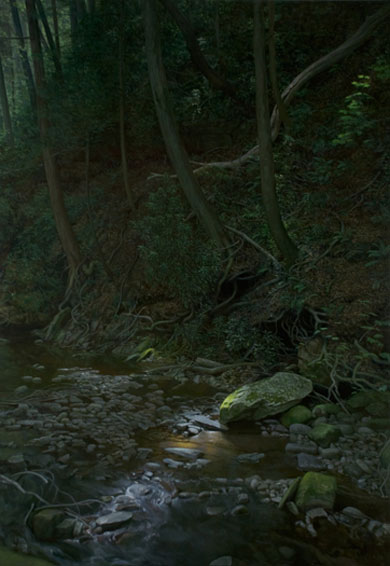 Treasure, 54"x38", oil on canvas Treasure, 54"x38", oil on canvas
back to publications list. |
|